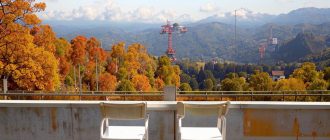
President of Pro-Vision, author of the Vinogradov.story community
“On the map of Russia and the post-Soviet space there are places where the heart sinks with pain and gratitude, and tears involuntarily come to the eyes. These are the memorials of the Great Patriotic War. Designed to preserve the memory of those who heroically died defending their homeland, the monuments of military glory rise above the cities and battlefields, carefully protecting the heritage of the country. Probably, every Russian settlement has its own Eternal Flame or local memorial. I will tell you about the most famous and large-scale ones”.
Patriot Park and the Main Temple of the Russian Armed Forces, Moscow Region
Patriot Park opened in 2015 near Kubinka near Moscow on an area of 5,500 hectares. Built as a military-patriotic complex of the Russian Armed Forces, by the 75th anniversary of the victory it acquired its main value – the Cathedral of the Resurrection of Christ, a monumental spiritual symbol glorifying the greatest victory of life over death.
The decoration of the temple combines recognizable features of the Russian style and innovations atypical for Orthodox architecture. Thus, on the walls you can see not only biblical subjects, but also battle scenes, on the floor – melted tank linings. And each of the aisles is dedicated to the patron saint of one of the branches of the Russian Armed Forces.
A poignant sculptural composition “To the Mothers of Winners”, depicting a grieving woman, is facing the temple. It is impossible to describe what feelings this sculpture evokes. As well as the emotions overflowing during a walk along the interactive museum “Memory Road”, where war chronicles and portraits of war participants surround you during the 1418 steps to victory – the number of days of the Great Patriotic War.
Mamaev Kurgan, Volgograd
Walking along the picturesque bank of the Volga River on a sunny May day, it is hard to imagine that in the fall of 1942 there were fierce battles of one of the largest general battles of the war – the Battle of Stalingrad. To commemorate it, the ensemble “To the Heroes of the Battle of Stalingrad” with the legendary monument “Motherland Calls!” was built on Mamaev Kurgan.
The monument can be seen from many points of modern Volgograd, but up close it amazes with its size and masterful execution. The image of the Motherland, which raises her sons to fight the enemy, is read in an instant and evokes an endless sense of pride. When you get acquainted with other objects of the complex, the Hall of Military Glory and the memorial cemetery, it is complemented by other emotions – gratitude and sorrow.
“Broken Ring”, Leningrad Region
Perhaps one of the most chamber-like yet poignant monuments of the war is the “Broken Ring” on Lake Ladoga. During the horrifying days of the siege of Leningrad, the Road of Life ran along the lake ice, thanks to which the surrounded city had not only minimal food and supplies, but also the most important thing – hope.
The symbolism of the “Broken Ring” erected 20 years later is clear without words: two semi-arches are two parts of the terrible siege ring, and the gap between them is the dangerous, difficult, but saving Road of Life. The monument is part of the “Green Belt of Glory” on the borders of the battle for Leningrad, so anyone interested in this tragic page of history should definitely visit its other objects, including the “Flower of Life”, dedicated to the dead children of the Siege of Leningrad.
Rzhevsky Memorial to the Soviet Soldier, Tver Region
Tvardovsky’s deafening lines “I was killed near Rzhev…”, known to every schoolchild, are dedicated to the places where the events of the Rzhevsko-Vyazemsky operation unfolded – and more than 70 years later, grateful descendants erected the grandiose Rzhevsky Memorial to the Soviet Soldier.
Not only Tvardovsky’s poem, but also other legendary works – Rasul Gamzatov’s “The Cranes” and Grigory Chukhray’s “Ballad of a Soldier” – can be recognized in the composition. This contrast of military images familiar from childhood and their monumental comprehension is the strength of the emotional impact of the memorial – it is impossible to leave here indifferent.
Sevastopol, Crimea
Sevastopol could be called one continuous open-air memorial complex, but still it has its own special places of memory. These are the Memorial to the Heroes of the Defense of Sevastopol on Nakhimov Square, and Malakhov Kurgan on the Ship side, and the diorama “The Assault of Sapun Mountain”, and many others.
You should definitely visit Sevastopol on May 9: watch the parade of warships, walk around the jubilant city and give flowers to veterans, who, unfortunately, every year you meet less and less often. And that is why you appreciate such moments especially.






